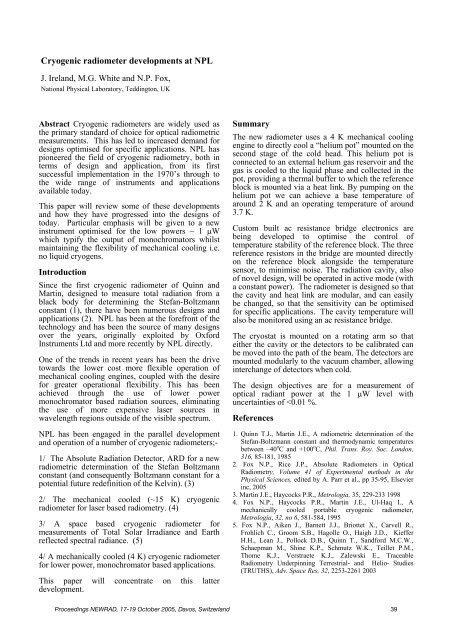Here - PMOD/WRC
Here - PMOD/WRC
Here - PMOD/WRC
You also want an ePaper? Increase the reach of your titles
YUMPU automatically turns print PDFs into web optimized ePapers that Google loves.
Cryogenic radiometer developments at NPL<br />
J. Ireland, M.G. White and N.P. Fox,<br />
National Physical Laboratory, Teddington, UK<br />
Abstract Cryogenic radiometers are widely used as<br />
the primary standard of choice for optical radiometric<br />
measurements. This has led to increased demand for<br />
designs optimised for specific applications. NPL has<br />
pioneered the field of cryogenic radiometry, both in<br />
terms of design and application, from its first<br />
successful implementation in the 1970’s through to<br />
the wide range of instruments and applications<br />
available today.<br />
This paper will review some of these developments<br />
and how they have progressed into the designs of<br />
today. Particular emphasis will be given to a new<br />
instrument optimised for the low powers ~ 1 µW<br />
which typify the output of monochromators whilst<br />
maintaining the flexibility of mechanical cooling i.e.<br />
no liquid cryogens.<br />
Introduction<br />
Since the first cryogenic radiometer of Quinn and<br />
Martin, designed to measure total radiation from a<br />
black body for determining the Stefan-Boltzmann<br />
constant (1), there have been numerous designs and<br />
applications (2). NPL has been at the forefront of the<br />
technology and has been the source of many designs<br />
over the years, originally exploited by Oxford<br />
Instruments Ltd and more recently by NPL directly.<br />
One of the trends in recent years has been the drive<br />
towards the lower cost more flexible operation of<br />
mechanical cooling engines, coupled with the desire<br />
for greater operational flexibility. This has been<br />
achieved through the use of lower power<br />
monochromator based radiation sources, eliminating<br />
the use of more expensive laser sources in<br />
wavelength regions outside of the visible spectrum.<br />
NPL has been engaged in the parallel development<br />
and operation of a number of cryogenic radiometers;-<br />
1/ The Absolute Radiation Detector, ARD for a new<br />
radiometric determination of the Stefan Boltzmann<br />
constant (and consequently Boltzmann constant for a<br />
potential future redefinition of the Kelvin). (3)<br />
2/ The mechanical cooled (~15 K) cryogenic<br />
radiometer for laser based radiometry. (4)<br />
3/ A space based cryogenic radiometer for<br />
measurements of Total Solar Irradiance and Earth<br />
reflected spectral radiance. (5)<br />
4/ A mechanically cooled (4 K) cryogenic radiometer<br />
for lower power, monochromator based applications.<br />
This paper will concentrate on this latter<br />
development.<br />
Summary<br />
The new radiometer uses a 4 K mechanical cooling<br />
engine to directly cool a “helium pot” mounted on the<br />
second stage of the cold head. This helium pot is<br />
connected to an external helium gas reservoir and the<br />
gas is cooled to the liquid phase and collected in the<br />
pot, providing a thermal buffer to which the reference<br />
block is mounted via a heat link. By pumping on the<br />
helium pot we can achieve a base temperature of<br />
around 2 K and an operating temperature of around<br />
3.7 K.<br />
Custom built ac resistance bridge electronics are<br />
being developed to optimise the control of<br />
temperature stability of the reference block. The three<br />
reference resistors in the bridge are mounted directly<br />
on the reference block alongside the temperature<br />
sensor, to minimise noise. The radiation cavity, also<br />
of novel design, will be operated in active mode (with<br />
a constant power). The radiometer is designed so that<br />
the cavity and heat link are modular, and can easily<br />
be changed, so that the sensitivity can be optimised<br />
for specific applications. The cavity temperature will<br />
also be monitored using an ac resistance bridge.<br />
The cryostat is mounted on a rotating arm so that<br />
either the cavity or the detectors to be calibrated can<br />
be moved into the path of the beam. The detectors are<br />
mounted modularly to the vacuum chamber, allowing<br />
interchange of detectors when cold.<br />
The design objectives are for a measurement of<br />
optical radiant power at the 1 µW level with<br />
uncertainties of
















